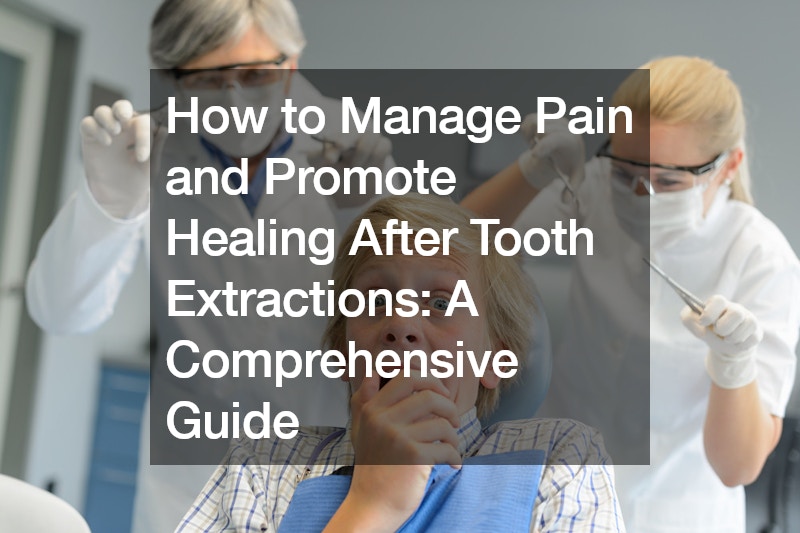How to Manage Pain and Promote Healing After Tooth Extractions A Comprehensive Guide


Tooth extractions are a common dental procedure for various reasons, including impacted wisdom teeth, severe decay, or periodontal disease. While the procedure itself is usually performed with anesthesia to minimize discomfort, some post-operative pain and swelling are normal. This comprehensive guide equips you with effective strategies to manage pain and promote optimal healing after tooth extraction.
Understanding Post-Extraction Discomfort:
Following a tooth extraction, you can expect tenderness, throbbing pain, and swelling around the site. These are temporary side effects caused by inflammation and tissue disruption during the procedure.
The level of discomfort can vary depending on the complexity of the extraction and your pain tolerance.
Managing Pain Effectively:
Pain Medication: Your dentist will likely prescribe pain medication to manage post-extraction discomfort. Take the medication exactly as prescribed, and don’t hesitate to contact your dentist if the pain is not adequately controlled.
Over the counter Pain Relievers: Over the counter Pain relievers like ibuprofen or acetaminophen can also help manage pain. Follow the recommended dosage instructions on the label and consult your dentist before using any of it, especially if you have any pre-existing medical conditions.
Cold Compress: Applying a cold compress wrapped in a thin cloth to the cheek near the extraction site can help reduce swelling and alleviate pain. Apply the compress for 15-20 minutes, with breaks in between to prevent skin irritation.
Promoting Optimal Healing:
Bleeding Control: A blood clot forms in the socket following tooth extraction to initiate healing. It’s crucial to minimize bleeding to prevent complications. Gently bite on a gauze pad placed over the extraction site for 30 minutes to promote clotting. Avoid spitting, rinsing your mouth, or using a straw for the first 24 hours, as this can dislodge the clot.
Rest and Relaxation: Prioritize rest within 24-48 hours after extraction. Avoid strenuous activity that can increase blood pressure and worsen discomfort.
Dietary Modifications: Stick to a soft diet of cool or lukewarm liquids and soft foods like mashed potatoes, yogurt, and applesauce for the first few days. Avoid hard, crunchy, or spicy foods irritating the extraction site.
Oral Hygiene: Good oral hygiene is essential for optimal healing and infection prevention. Gently brush your teeth and rinse your mouth with warm salt water (half a teaspoon of salt dissolved in a glass of warm water) several times daily, starting 24 hours after the extraction. Avoid brushing directly around the extraction site.
Additional Tips for a Smooth Recovery:
Elevate Your Head: When sleeping or resting, elevate your head with extra pillows to minimize swelling.
Avoid Smoking: Smoking can slow down healing and increase the risk of infection. Avoid smoking for at least a week after your extraction.
Minimize Alcohol Consumption: Alcohol can interfere with healing and may interact with pain medication. Avoid alcohol consumption for the first 24 hours after your extraction.
Monitor for Signs of Infection: While some discomfort is normal, be aware of potential signs of infection that may require immediate dental attention. These include persistent fever, severe throbbing pain, or pus draining from the extraction site.
When to Contact Your Dentist:
Excessive Bleeding: If bleeding persists for more than 24 hours after your extraction, contact your dentist for instructions.
Severe Pain: If the prescribed pain medication doesn’t adequately manage your pain, contact your dentist to discuss alternative options.
Signs of Infection: If you experience symptoms like fever, severe pain, or pus drainage, contact your dentist immediately for an evaluation and treatment.
Promoting Overall Well-Being During Recovery:
Hydration: Drink plenty of fluids to stay hydrated and promote healing. Avoid sugary drinks, as they can contribute to inflammation.
Nutritious Diet: Choose nutritious foods rich in vitamins and minerals to support your body’s healing process.
Rest: Prioritize getting enough sleep and relaxation during your recovery period.
Recovery Timeline:
While healing times can vary depending on the complexity of the extraction and individual factors, here’s a general timeline to manage expectations:
First Day: Expect discomfort, swelling, and minimal bleeding.
2-3 Days: Discomfort and swelling should gradually decrease.
7-10 Days: Most of the swelling and discomfort should decrease.
2 Weeks: The extraction site should be mostly healed, and you can gradually resume your regular diet.
6-8 Weeks: The bone socket should be completely healed, and your dentist may recommend placing a dental implant or bridge to restore the missing tooth and maintain proper oral function.
Conclusion:
Tooth extractions are a common dental procedure, and with proper care, you can manage pain effectively and promote optimal healing. By following the tips outlined in this guide, you can ensure a smooth recovery and get back to enjoying your favorite foods and activities without discomfort. Remember, open communication with your dentist is crucial throughout the process. Don’t hesitate to ask questions or voice any concerns you may have to ensure a successful recovery and a healthy smile.
.
